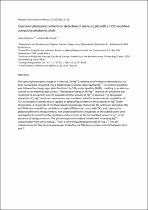 ResearchSpace
ResearchSpace
Improved photoelectrochemical detection of mercury (II) with a TiO2-modified composite photoelectrode
JavaScript is disabled for your browser. Some features of this site may not work without it.
- ResearchSpace
- →
- Research Publications/Outputs
- →
- Journal Articles
- →
- View Item
| dc.contributor.author |
Chamier, J

|
|
| dc.contributor.author |
Crouch, AM

|
|
| dc.date.accessioned | 2012-05-08T13:16:47Z | |
| dc.date.available | 2012-05-08T13:16:47Z | |
| dc.date.issued | 2012-01 | |
| dc.identifier.citation | Chamier, J and Crouch, AM. 2012. Improved photoelectrochemical detection of mercury (II) with a TiO2-modified composite photoelectrode. Materials Chemistry and Physics, vol. 132(1), pp 10-16 | en_US |
| dc.identifier.issn | 0254-0584 | |
| dc.identifier.uri | http://www.sciencedirect.com/science/article/pii/S025405841100558X | |
| dc.identifier.uri | http://hdl.handle.net/10204/5847 | |
| dc.description | Copyright: 2011 Elsevier. This is an ABSTRACT ONLY. | en_US |
| dc.description.abstract | The spectrophotometric change of amercury (II) (Hg2+) selective small molecule chemosensor has been successfully converted into a photovoltaic response upon ligating Hg2+. The photon excitation was followed by charge separation facilitated by TiO2 and polyaniline (PANI), resulting in an electron transfer to an electrical back contact. The photoresponse of the Hg2+ selective chromophore was converted to an electron current equivalent to the amount of Hg2+ in solution. The favourable properties of a Hg2+ sensitive chemosensor was combined with the semiconductor capabilities of TiO2 to construct a sensor that is capable of generating a current in the presence of Hg2+ under illumination. A composite of the fluorescent chemosensor rhodamine 6G hydrozone derivative (RS) and PANI was immobilized on indium tin oxide (ITO) plates coated with TiO2 and subjected to photovoltammetric measurements. The photovoltammetric responses of the coated layers were investigated to determine the sensitivity and selectivity of the immobilized sensor to Hg2+ in the presence of background ions. The photo-response increased linearly with increasing Hg2+ concentration from 10 to 200 µg L-1 with a limit of quantification (LOQ) of 4 µg L-1. The pH independence for the photoresponse was limited by the TiO2 layer and was optimal between pH 6 and 7. | en_US |
| dc.language.iso | en | en_US |
| dc.publisher | Elsevier | en_US |
| dc.relation.ispartofseries | Workflow;8552 | |
| dc.subject | Photoelectrochemical cells | en_US |
| dc.subject | Mercury (II) | en_US |
| dc.subject | Rhodamine 6G | en_US |
| dc.subject | TiO2 | en_US |
| dc.subject | Polyaniline | en_US |
| dc.title | Improved photoelectrochemical detection of mercury (II) with a TiO2-modified composite photoelectrode | en_US |
| dc.type | Article | en_US |
| dc.identifier.apacitation | Chamier, J., & Crouch, A. (2012). Improved photoelectrochemical detection of mercury (II) with a TiO2-modified composite photoelectrode. http://hdl.handle.net/10204/5847 | en_ZA |
| dc.identifier.chicagocitation | Chamier, J, and AM Crouch "Improved photoelectrochemical detection of mercury (II) with a TiO2-modified composite photoelectrode." (2012) http://hdl.handle.net/10204/5847 | en_ZA |
| dc.identifier.vancouvercitation | Chamier J, Crouch A. Improved photoelectrochemical detection of mercury (II) with a TiO2-modified composite photoelectrode. 2012; http://hdl.handle.net/10204/5847. | en_ZA |
| dc.identifier.ris | TY - Article AU - Chamier, J AU - Crouch, AM AB - The spectrophotometric change of amercury (II) (Hg2+) selective small molecule chemosensor has been successfully converted into a photovoltaic response upon ligating Hg2+. The photon excitation was followed by charge separation facilitated by TiO2 and polyaniline (PANI), resulting in an electron transfer to an electrical back contact. The photoresponse of the Hg2+ selective chromophore was converted to an electron current equivalent to the amount of Hg2+ in solution. The favourable properties of a Hg2+ sensitive chemosensor was combined with the semiconductor capabilities of TiO2 to construct a sensor that is capable of generating a current in the presence of Hg2+ under illumination. A composite of the fluorescent chemosensor rhodamine 6G hydrozone derivative (RS) and PANI was immobilized on indium tin oxide (ITO) plates coated with TiO2 and subjected to photovoltammetric measurements. The photovoltammetric responses of the coated layers were investigated to determine the sensitivity and selectivity of the immobilized sensor to Hg2+ in the presence of background ions. The photo-response increased linearly with increasing Hg2+ concentration from 10 to 200 µg L-1 with a limit of quantification (LOQ) of 4 µg L-1. The pH independence for the photoresponse was limited by the TiO2 layer and was optimal between pH 6 and 7. DA - 2012-01 DB - ResearchSpace DP - CSIR KW - Photoelectrochemical cells KW - Mercury (II) KW - Rhodamine 6G KW - TiO2 KW - Polyaniline LK - https://researchspace.csir.co.za PY - 2012 SM - 0254-0584 T1 - Improved photoelectrochemical detection of mercury (II) with a TiO2-modified composite photoelectrode TI - Improved photoelectrochemical detection of mercury (II) with a TiO2-modified composite photoelectrode UR - http://hdl.handle.net/10204/5847 ER - | en_ZA |





